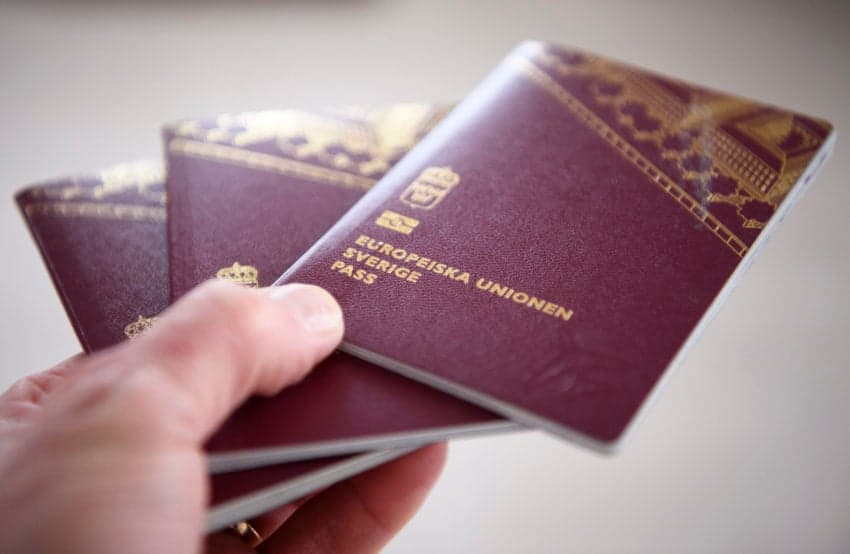How many people got Swedish citizenship in 2022 and where were they from?

Just under 90,000 people became Swedish citizens in 2022. Which countries were most people from and how does this compare to previous years?
Last year, the number of new Swedish citizens reached 89,967 – an increase on 2021. This figure includes secondary applicants - children who were granted citizenship in a joint application with their parent - as well as people whose application was rejected by the Migration Agency but approved by an appeals court.
The Migration Agency received a total of 88,968 applications in 2022 (not including secondary applicants), and 94,292 were processed, including applications received in previous years. Of these, 78,201 were approved, 13,230 were rejected, 572 were listed as "invalid" and 2,289 were in the "other" category.
This is also an increase on 2021, when 71,229 citizenship applications were approved.
The average time for an application to be processed, according to Migration Agency figures, had risen to 431 days, (356 in 2021 and 376 in 2020), with the median time for processing dropping to 256 days (compared to 330 in 2021 and 315 in 2020). An average of 83 percent of applications were successful.
"We've managed to change the trend and shorten the processing time for citizenship," Migration Agency general director Mikael Ribbenvik said, referring to the drop in the median processing time.
READ ALSO:
Of those who became Swedish citizens in 2022 (including children receiving citizenship alongside a parent), 21.7 percent came from Syria (19,501).
The next most common countries of origin for applicants in the top ten were Eritrea (8,500), Somalia (5,954), Afghanistan (5,623), Iraq (3,197), India (2,879), Poland (2,085), Iran (1,848), Turkey (1,678) and Thailand (1,541). This top ten is almost identical to last year, when Germany was in the top ten instead of Turkey.
In November 2022, Sweden had a population of 10,520,558 according to Statistics Sweden, meaning 2022’s new Swedish citizens represent less than one percent of the population.
Comments
See Also
Last year, the number of new Swedish citizens reached 89,967 – an increase on 2021. This figure includes secondary applicants - children who were granted citizenship in a joint application with their parent - as well as people whose application was rejected by the Migration Agency but approved by an appeals court.
The Migration Agency received a total of 88,968 applications in 2022 (not including secondary applicants), and 94,292 were processed, including applications received in previous years. Of these, 78,201 were approved, 13,230 were rejected, 572 were listed as "invalid" and 2,289 were in the "other" category.
This is also an increase on 2021, when 71,229 citizenship applications were approved.
The average time for an application to be processed, according to Migration Agency figures, had risen to 431 days, (356 in 2021 and 376 in 2020), with the median time for processing dropping to 256 days (compared to 330 in 2021 and 315 in 2020). An average of 83 percent of applications were successful.
"We've managed to change the trend and shorten the processing time for citizenship," Migration Agency general director Mikael Ribbenvik said, referring to the drop in the median processing time.
READ ALSO:
Of those who became Swedish citizens in 2022 (including children receiving citizenship alongside a parent), 21.7 percent came from Syria (19,501).
The next most common countries of origin for applicants in the top ten were Eritrea (8,500), Somalia (5,954), Afghanistan (5,623), Iraq (3,197), India (2,879), Poland (2,085), Iran (1,848), Turkey (1,678) and Thailand (1,541). This top ten is almost identical to last year, when Germany was in the top ten instead of Turkey.
In November 2022, Sweden had a population of 10,520,558 according to Statistics Sweden, meaning 2022’s new Swedish citizens represent less than one percent of the population.
Join the conversation in our comments section below. Share your own views and experience and if you have a question or suggestion for our journalists then email us at [email protected].
Please keep comments civil, constructive and on topic – and make sure to read our terms of use before getting involved.
Please log in here to leave a comment.